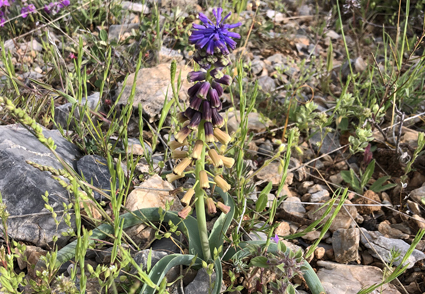Abstract
Leopoldia oztasii sp. nov. (Asparagaceae, Scilloideae) is described as a new species in this study. It spreads on the stony slopes of Konya province in the south of Türkiye. Leopoldia oztasii is similar to L. tenuiflora, but it is easily distinguished from it, by having larger bulbs, falcate leaves, shorter scape, conical inflorescence, longer pedicels, and larger capsules. In this study, the morphology, seed surface characteristics and ecology of L. oztasii were studied. A detailed description of the new species, a comparison table between the two species, and detailed photographs showing their differences are provided. The distribution areas of L. oztasii and L. tenuiflora in Türkiye are also presented on the map.
References
- Bentzer, B. (1973) Taxonomy, variation and evolution in representatives of Leopoldia Parl. (Liliaceae) in the Southern and Central Aegean. Botaniska Notiser 126: 69–132.
- Bojňansky, V. & Fargašová, A. (2007) Atlas of Seeds and Fruits of Central and East-European Flora: the Carpathian Mountains Region. Springer, Netherlands, 1046 pp. https://doi.org/10.1007/978-1-4020-5362-7
- Böhnert, T., Neumann, M., Quandt, D. & Weigend, M. (2023) Phylogeny based generic reclassification of Muscari sensu lato (Asparagaceae) using plastid and genomic DNA. Taxon 72 (2): 261–277. https://doi.org/10.1002/tax.12864
- Corner, E.J. (1976) The Seeds of Dicotyledons 1. Cambridge University Press, Cambridge, 324 pp.
- Davis, P.H. & Stuart, D.C. (1980) Muscari Mill. In: Tutin, T.G., Heywood, V.H., Valentine, D.H. (Eds.) Flora Europaea 5. Cambridge University Press, London, pp. 46–49.
- Davis, P.H. & Stuart, D.C. (1984) Muscari Mill. In: Davis, P.H. (Ed.) Flora of Turkey and the East Aegean Islands 8. Edinburgh University Press, Edinburgh, pp. 245–263.
- Demirci, S., Özhatay, N. & Koçyiğit, M. (2013) Muscari erdalii (Asparagaceae, Scilloideae), a new species from Southern Turkey. Phytotaxa 154 (1): 38–46. https://doi.org/10.11646/phytotaxa.154.1.2
- Dizkirici, A., Yigit, O., Pınar, S.M. & Eroğlu, H. (2019) Molecular phylogeny of Muscari (Asparagaceae) inferred from cpDNA sequences. Biologia 74: 205–214. https://doi.org/10.2478/s11756-018-00164-0
- Eker, İ (2021a) What is Muscari massayanum and what is not? Second species born of confusion: Muscari erzincanicum (Asparagaceae, Scilloideae), a new species from Turkey. Phytotaxa 487 (1): 41–55. https://doi.org/10.11646/phytotaxa.487.1.3
- Eker, İ. (2021b) Taxonomic resurrection of Muscari wallii (Asparagaceae, Scilloideae). Phytotaxa 513 (3): 226–242. https://doi.org/10.11646/phytotaxa.513.3.3
- Eker, İ. (2022) Muscari Mill. / Müşkürüm, Muscarimia Kostel. ex Losinsk. / Miskîrum, Leopoldia Parl. / Morbaş. In: Güner, A., Kandemir, A., Menemen, Y., Yıldırım, H., Aslan, S., Ekşi, G., Güner, I., Çimen, A.Ö. & Şen, F. (Eds.) The Illustrated Flora of Turkey web version. ANG Foundation Nezahat Gökyiğit Botanik Bahçesi Publications, İstanbul, 99 pp. [eISBN: 978-605-70199-4-3] https://doi.org/10.30796/ANGV.2022.15
- Eroğlu, H., Karaismailoğlu, M.C., Pınar, S.M. & Fidan, M. (2021) Seed micromorphology and anatomy of 36 Muscari (Asparagaceae) taxa from Turkey with notes on their systematic importance. Acta Botanica Croatica 80 (2): 146–157. https://doi.org/10.37427/botcro-2021-015
- Eroğlu, H., Karaismailoğlu, M.C., Fidan, M. & Pınar, S.M. (2022) Seed Morphological and Anatomical Structures as Taxonomy Tool for Turkish Hyacinthella Schur (Asparagaceae) Taxa. Phytotaxa 564 (2): 191–207. https://doi.org/10.11646/phytotaxa.564.2.3
- Garbari, F. & Greuter, W. (1970) On the taxonomy and typification of Muscari Miller (Liliaceae) and allied genera, and on the typification of generic names. Taxon 19: 329–335. https://doi.org/10.2307/1219056
- Grunert, C. (1931) Muscari massayanum. Gartenwelt 35: 205. https://doi.org/10.1115/1.4022735
- Heldreich, T. (1878) Über die Liliaceen-Gattung Leopoldia. Bulletin de la Société Imperiale des Naturalistes de Moscou 53 (1): 56–75.
- Karaismailoğlu, M.C. & Erol, O. (2018) Seed structure and its taxonomic implications for genus Thlaspi sensu lato sections Nomisma, Thlaspi and Pterotropis (Brassicaceae). Turkish Journal of Botany 42: 591–609. https://doi.org/10.3906/bot-1709-28
- Losina-Losinskaja, A.S. (1935) Muscarimia Kostel. In: Komarov, V.L. (Ed.) Flora URSS 4. Nauka Press, Leningrad, pp. 410–411.
- Losina-Losinskaja, A.S. (1968) Muscari Mill. In: Komarov, V.L. (Ed.) Flora of the U.S.S.R. IV. Israel Program for Scientific Translations, Jerusalem, pp. 316–324. [Translated from Russian (1935)]
- Menemen, Y., Aytaç, Z. & Kandemir, A. (2016) Türkçe Bilimsel Bitki Adlandırma Yönergesi. Bağbahçe Bilim Dergisi 3 (3): 1–3.
- Miller, P. (1754) The Gardeners Dictionary, Ed. 4. London, 926 pp.
- Parlatore, F. (1845) Flora Palermitana Ossia Descrizione Delle Piante Che Crescono Spontanee Nella Valle di Palermo. Accademia Nazionale di Scienze, Lettere e Arti, Palermo, 442 pp.
- Post, G.E. & Dinsmore, J.E. (1933) Flora of Syria, Palestine and Sinai 2. American Press, Beirut, 928 pp.
- Rechinger, K. (1990) Liliaceae II. In: Browicz, K.H., Persson, K. & Wendelbo, P. (Eds.) Flora Iranica 165. Verlagsanstatt, Austria: Akademic Druck. U., Graz, pp. 140–148.
- Speta, F. (1982) Über die Abgrenzung und Gliederung der Gattung Muscari und über ihre Beziehungen zu anderen Vertretern der Hyacinthaceae. Botanische Jahrbücher fur Systematik 103: 247–291.
- Speta, F. (1989) Muscari (subg. Leopoldia) mirum Speta, spec. nova, im Kreise seiner nächsten Verwandten. Phyton 29: 105–117.
- Stearn, W.T. (1983) Botanical Latin. 3rd edition. Timber Press, Oregon, 560 pp.
- Stuart, D.C. (1985) Muscari Mill. In: Townsend, C.C. & Guest, E. (Eds.) Flora of Iraq 8. Ministry of Agriculture and Agrarian Reform, Baghdad, pp. 126–135.
- Tausch, I.F. (1841) Botanische Beobachtungen über einige monocotyledonische Gewächse. Flora 15: 225–240.
- Thiers, B. (2023 [continuously updated]) Index Herbariorum: A Global Directory of Public Herbaria and Associated Staff. New York Botanical Garden’s Virtual Herbarium. Available from: http://sweetgum.nybg.org/science/ih/ (accessed: 15 October 2023).


